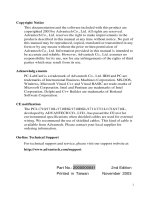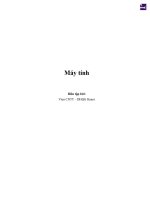Tài liệu về PCI 1710
Bạn đang xem bản rút gọn của tài liệu. Xem và tải ngay bản đầy đủ của tài liệu tại đây (2.69 MB, 164 trang )
i
Copyright Notice
This documentation and the software included with this product are
copyrighted 2003 by Advantech Co., Ltd. All rights are reserved.
Advantech Co., Ltd. reserves the right to make improvements in the
products described in this manual at any time without notice. No part of
this manual may be reproduced, copied, translated or transmitted in any
form or by any means without the prior written permission of
Advantech Co., Ltd. Information provided in this manual is intended to
be accurate and reliable. However, Advantech Co., Ltd. assumes no
responsibility for its use, nor for any infringements of the rights of third
parties which may result from its use.
Acknowledgements
PC-LabCard is a trademark of Advantech Co., Ltd. IBM and PC are
trademarks of International Business Machines Corporation. MS-DOS,
Windows, Microsoft Visual C++ and Visual BASIC are trade-marks of
Microsoft Corporation. Intel and Pentium are trademarks of Intel
Corporation. Delphi and C++ Builder are trademarks of Borland
Software Corporation.
CE notification
The PCI-1710/1710L/1710HG/1710HGL/1711/1711L/1716/1716L,
developed by ADVANTECH CO., LTD., has passed the CE test for
environmental specifications when shielded cables are used for external
wiring. We recommend the use of shielded cables. This kind of cable is
available from Advantech. Please contact your local supplier for
ordering information.
On-line Technical Support
For technical support and service, please visit our support website at:
Part No.: 2000000041 2nd Edition
Printed in Taiwan November 2003
ii
(This page is left blank for hard printing.)
iii
Contents
1. Introduction···········································································································3
1.1 Features ·········································································································5
1.2 Installation Guide ························································································9
1.3 Software ······································································································11
1.4 Accessories ·································································································12
2. Installation···········································································································17
2.1 Unpacking···································································································17
2.2 Driver Installation······················································································19
2.3 Hardware Installation················································································21
2.4 Device Setup & Configuration································································24
2.5 Device Testing····························································································28
3. Signal Connections ····························································································37
3.1 Overview·····································································································37
3.2 I/O Connector·····························································································37
3.3 Analog Input Connections········································································41
3.4 Analog Output Connections·····································································46
3.5 Trigger Source Connections····································································47
3.6 Field Wiring Considerations····································································48
4. Software Overview·····························································································53
4.1 Programming Choices ··············································································53
4.2 DLL Driver Programming Roadmap ·····················································54
5. Calibration···········································································································61
5.1 PCI-1710/1710L/1710HG/1710HGL Calibration ·······························62
iv
5.2 PCI-1711/1711L Calibration····································································67
5.3 PCI-1716/1716L Calibration···································································71
Appendix A. Specifications ··················································································87
A.1 PCI-1710/1710L/1710HG/1710HGL ···················································87
A.2 PCI-1711/1711L Specifications·····························································90
A.3 PCI-1716/1716L Specifications·····························································92
Appendix B. Block Diagrams ··············································································95
B.1 Block Diagram of PCI-1710/1710L/1710HG/1710HGL ··················95
B.2 Block Diagram of PCI-1711/1711L·······················································96
B.3 Block Diagram of PCI-1716/1716L······················································97
Appendix C. Register Structure and Format··················································99
C.1 Overview····································································································99
C.2 I/O Port Address Map···········································································100
C.3 Channel Number and A/D Data — BASE+0 and BASE+1···········107
C.4 Software A/D Trigger — BASE+0·····················································109
C.5 A/D Channel Range Setting — BASE+2··········································110
C.6 MUX Control — BASE+4 and BASE+5··········································114
C.7 Control Register — BASE+6······························································118
C.8 Status Register — BASE+6 and BASE+7········································121
C.9 Clear Interrupt and FIFO — BASE+8 and BASE+9·······················122
C.10 D/A Output Channel 0 — BASE+10 and BASE+11····················122
C.11 D/A Output Channel 0 — BASE+10 and BASE+11·····················123
C.12 D/A Output Channel 1 — BASE+12 and BASE+13 ····················124
C.13 D/A Output Channel 1 — BASE+12 and BASE+13 ····················125
C.14 D/A Reference Control — BASE+14 ···············································126
v
C.15 Digital I/O Registers — BASE+16 and BASE+17·······················128
C.16 Calibration Registers — BASE+18 and BASE+19·······················129
C.17 Board ID Registers — BASE+20·····················································131
C.18 Programmable Timer/Counter Registers BASE+24,
BASE+26, BASE+28 and BASE+30···············································131
Appendix D. 82C54 Counter Chip Function·················································133
D.1 The Intel 82C54·····················································································133
D.2 Counter Read/Write and Control Registers·······································135
D.3 Counter Operating Modes····································································139
D.4 Counter Operations···············································································142
Appendix E. PCI-1716/1716L Calibration (Manually)······························145
E.1 A/D Calibration······················································································145
E.2 D/A Calibration (for PCI-1716 only)··················································148
Appendix F. Screw-terminal Board·································································153
F.1 Introduction·····························································································153
F.2 Features ····································································································154
F.3 Applications·····························································································154
vi
(This page is left blank for hard printing.)
vii
Tables
Table 3-1 I/O Connector Signal Description ························································40
Table C-1 PCI-1710/1710L/1710HG/1710HGL/1711/1711L register
format (Part 1)······················································································101
Table C-1 PCI-1716/1716L register format (Part 2)·········································102
Table C-1 PCI-1710/1710L/1710HG/1710HGL/1711/1711L/
1716/1716L register format (Part 3)·················································103
Table C-1 PCI-1710/1710L/1710HG/1710HGL/1711/1711L register
format (Part 4)······················································································104
Table C-1 PCI-1716/1716L register format (Part 5)·········································105
Table C-1 PCI-1710/1710L/1710HG/1710HGL/1711/1711L/
1716/1716L register format (Part 6)·················································106
Table C-2 PCI-1710/1710L/1710HG/1710HGL/1711/1711L Register
for channel number and A/D data·····················································107
Table C-3 PCI-1716/1716L Register for A/D data···········································108
Table C-4 Register for A/D channel range setting············································110
Table C-5 Gain codes for PCI-1710/1710L························································111
Table C-6 Gain codes for PCI-1710HG/1710HGL ··········································112
Table C-7 Gain codes for PCI-1711/1711L························································113
Table C-8 Register for multiplexer control························································114
Table C-9 Control Register···················································································118
Table C-10 Status Register····················································································121
Table C-11 Register to clear interrupt and FIFO···············································122
Table C-12 Register for load D/A channel 0 data·············································122
Table C-13 Register for D/A channel 0 data······················································123
viii
Table C-14 Register for load D/A channel 1 data·············································124
Table C-15 Register for D/A channel 1 data······················································125
Table C-16 PCI-1710/1710HG/1711 Register for D/A reference control····126
Table C-17 PCI-1716 Register for D/A reference control······························126
Table C-18 Register for digital input··································································128
Table C-19 Register for digital output································································128
Table C-20 Calibration Command and Data Register·····································129
Table C-21 Calibration Command and Data Register·····································130
Table C-22 Register for Board ID ·······································································131
Table E-1 A/D binary code table··········································································147
Table E-2 D/A binary code table··········································································151
ix
Figures
Fig.1-1 Installation Flow Chart ···············································································10
Fig.2-1 The Setup Screen of Advantech Automation Software·························19
Fig.2-2 Different options for Driver Setup····························································20
Fig.2-3 The device name listed on the Device Manager····································23
Fig. 2-4 The Device Manager dialog box······························································25
Fig. 2-5 Selecting the device you want to install·················································25
Fig. 2-6 The Device Setting dialog box·································································26
Fig. 2-7 The Device Name appearing on the list of devices box···················27
Fig. 2-8 Analog Input tab on the Device Test dialog box···································28
Fig. 2-9 Analog Input tab on the Device Test dialog box···································29
Fig. 2-10 Analog Output tab on the Device Test dialog box······························30
Fig. 2-11 Digital Input tab on the Device Test dialog box·································31
Fig. 2-12 Digital Output tab on the Device Test dialog box······························32
Fig. 2-13 Counter tab on the Device Test dialog box··········································33
Fig. 3-1 I/O connector pin assignments for the PCI-1710/
1710L/1710HG/1710HGL/1711/1711L/1716/1716L······················39
Fig. 3-2 Single-ended input channel connection··················································42
Fig. 3-3 Differential input channel connection - ground reference signal
source········································································································43
Fig. 3-4 Differential input channel connection - floating signal source···········44
Fig. 3-5 Analog output connections·······································································46
Fig. 5-1 PCI-1710/1710L/L1710HG/1710HGL VR assignment······················63
Fig. 5-2 PCI-1711/1711L VR assignment·····························································68
Fig. 5-3 PCI-1716/1716L VR assignment·····························································71
x
Fig. 5-4 Selecting the device you want to calibrate·············································73
Fig. 5-5 Warning message before start calibration ··············································73
Fig. 5-6 Auto A/D Calibration Dialog Box···························································74
Fig. 5-7 A/D Calibration Procedure 1····································································74
Fig. 5-8 A/D Calibration Procedure 2····································································75
Fig. 5-9 A/D Calibration Procedure 3····································································75
Fig. 5-10 A/D Calibration is finished·····································································76
Fig. 5-11 Range Selection in D/A Calibration······················································77
Fig. 5-12 Calibrating D/A Channel 0·····································································77
Fig. 5-13 Calibrating D/A Channel 1·····································································78
Fig. 5-14 D/A Calibration is finished·····································································78
Fig. 5-15 Selecting Input Rage in Manual A/D Calibration panel·················80
Fig. 5-16 Adjusting registers···················································································80
Fig. 5-17 & Fig. 5-18 Selecting D/A Range and Choosing Output
Voltage······································································································82
Fig. 5-19 Adjusting registers···················································································83
1
Introduction
1
CHAPTER
2
(This page is left blank for hard printing.)
3
1. Introduction
Thank you for buying the Advantech PCI-1710/1710L/1710HG/
1710HGL/1711/1711L/1716/1716L PCI card. The Advantech PCI-
1710/1710L/1710HG/1710HGL/1711/1711L/1716/1716L is a
powerful data acquisition (DAS) card for the PCI bus. It features a
unique circuit design and complete functions for data acquisition and
control, including A/D conversion, D/A conversion, digital input,
digital output, and counter/timer. PCI-1710/1710L/1710HG/
1710HGL/1711/1711L/1716/1716L provides specific functions for
different user requirements:
The Advantech PCI-1710/1710L/1710HG/1710HGL/1711/1711L/
1716/1716L is a powerful data acquisition (DAS) card for the PCI
bus. It features a unique circuit design and complete functions for data
acquisition and control, including A/D conversion, D/A conversion,
digital input, digital output, and counter/timer.
PCI-1710/1710L/1710HG/1710HGL/1711/1711L/1716/1716L
provides specific functions for different user requirements:
PCI-1710 12-bit, 100kS/s Multifunction card
PCI-1710L 12-bit, 100kS/s Multifunction card w/o analog
output
PCI-1710HG 12-bit, 100kS/s High-Gain Multifunction card
PCI-1710HGL 12-bit, 100kS/s High-Gain Multifunction card
4
w/o analog output
PCI-1711 12-bit, 100kS/s 16-ch S.E. Inputs Low-cost
Multifunction card
PCI-1711L 12-bit, 100kS/s 16-ch S.E. Inputs Low-cost
Multifunction card w/o analog output
PCI-1716 16-bit, 250kS/s High-Resolution Multifunction
card
PCI-1716L 16-bit, 250kS/s High-Resolution Multifunction
card w/o analog output
The following sections of this chapter will provide further information
about features of the multifunction cards, a Quick Start for installation,
together with some brief information on software and accessories for
the PCI-1710/1710L/1710HG/1710HGL/1711/1711L/1716/1716L
card.
5
1.1 Features
The Advantech PCI-1710/1710L/1710HG/1710HGL/1711/1711L/
1716/1716L provides users with the most requested measurement and
control functions as below:
w PCI-bus mastering for data transfer
w 16-channel Single-Ended or 8 differential A/D Input
w 12-bit A/D conversion with up to 100 kHz sampling rate
(PCI-1710/1710L/1710HG/1710HGL/1711/1711L)
w 16-bit A/D conversion with up to 250 kHz sampling rate
(PCI-1716/1716L)
w Programmable gain for each input channel
(only for PCI-1710/1710L/1710HG/1710HGL/1716/1716L)
w On board samples FIFO buffer:
4K for PCI-1710/1710L/1710HG/1710HGL, 1K for PCI-1716/
1716L
w 2-channel D/A Output (PCI-1710/1710HG/1711/1716)
w 16-channel Digital Input
w 16-channel Digital Output
w Programmable Counter/Timer
w Automatic Channel/Gain Scanning
w Board ID
The Advantech PCI-1710/1710L/1710HG/1710HGL/1711/1711L/
1716/1716L offers the following main features:
6
Plug-and-Play Function
The Advantech PCI-1710/1710L/1710HG/1710HGL/1711/1711L/
1716/1716L is a Plug-and-Play device, which fully complies with the
PCI Specification. Rev 2.1 for PCI-1710/1710L/1710HG/1710HGL/
1711/1711L, and Rev 2.2 for PCI-1716/1716L. During card
installation, all bus-related configurations such as base I/O address
and interrupts are conveniently taken care of by the Plug-and-Play
function. You have virtually no need to set any jumpers or DIP
switches.
Flexible Input Type and Range Settings
The PCI-1710/1710L/1710HG/1710HGL/1711/1711L/1716/1716L
features an automatic channel/gain scanning circuit. This circuit
design controls multiplexer switching during sampling. Users can set
different gain values for each channel according to their needs for the
corresponding range of input voltage. The gain value settings thus
selected is stored in the SRAM. This flexible design enables
multi-channel and high-speed sampling for high-performance data
acquisition.
7
On-board FIFO (First-In-First-Out) Memory
The PCI-1710/1710L/1710HG/1710HGL/1711/1711L/1716/1716L
provides an on-board FIFO memory buffer, storing up to 4K A/D
samples. Users can either enable or disable the interrupt request
feature of the FIFO buffer. While the interrupt request for FIFO is
enabled, users are allowed to specify whether an interrupt request will
be sent with each sampling action or only when the FIFO buffer is half
saturated. This useful feature enables a continuous high-speed data
transfer with a more predictable performance on operating systems.
Optional D/A Output for Cost Savings
The PCI-1710/1710HG/1711/1716 goes further with 2 analog output
channels, while the PCI-1710L/1710HGL/1711L/1716L doesn’t. It is
for users to differentiate between the PCI-1710/1710HG/1711/1716
and the PCI-1710L/1710HGL/1711L/1716L according to what they
really need as the best solution with no extra cost.
16 Digital Inputs and 16 Digital Outputs
The PCI-1710/1710L/1710HG/1710HGL/1711/1711L/1716/1716L
provides 16 digital input channels and 16 digital output channels.
Users are left with great flexibility to design and customize their
applications according to their specific needs.
8
On-board Programmable Counter
The PCI-1710/1710L/1710HG/1710HGL/1711/1711L/1716/1716L is
equipped with a programmable counter, which can serve as a pacer
trigger for A/D conversions. The counter chip is an 82C54 or its
equivalent, which incorporates three 16-bit counters on a 10 MHz
clock. One of the three counters is used as an event counter for input
channels or pulse generation. The other two are cascaded into a 32-bit
timer for pacer triggering.
Short Circuit Protection
The PCI-1710/1710L/1710HG/1710HGL/1716/1716L is equipped
with short circuit protection device (polyswitch) on the +12V
DC
/
+5V
DC
power supply pins. If any of the power supply pins is shorted
to ground (i.e. short circuit occurs), the protection device will shut off
the current output automatically. After the short circuit has been
released for about two minutes, the power supply pins will return to
output current.
Note:
1. Pace trigger determines how fast A/D conversion will be done in pacer
trigger mode.
2. For detailed specifications of the PCI-1710/1710L/1710HG/1710HGL/
1711/1711L/1716/1716L, please refer to Appendix A, Specifications.
9
1.2 Installation Guide
Before you install your PCI-1710/1710L/1710HG/1710HGL/1711/
1711L/1716/1716L card, please make sure you have the following
necessary components:
w PCI-1710/1710L/1710HG/1710HGL/1711/1711L/1716/1716L
Multifunction card
w PCI-1710/1710L/1710HG/1710HGL/1711/1711L/1716/1716L
User’s Manual
w Driver software Advantech DLL drivers (included in the
companion CD-ROM)
w Wiring cable PCL-10168
w Wiring board PCLD-8710, ADAM-3968
w Computer Personal computer or workstation with a
PCI-bus slot (running Windows
95/98/NT/2000/XP)
Some other optional components are also available for enhanced
operation:
w Application software ActiveDAQ, GeniDAQ or other third-party
software packages
After you get the necessary components and maybe some of the
accessories for enhanced operation of your Multifunction card, you
can then begin the Installation procedures. Fig. 1-1 on the next page
provides a concise flow chart to give users a broad picture of the
software and hardware installation procedures:
10
Fig.1-1 Installation Flow Chart
11
1.3 Software
Advantech offers a rich set of DLL drivers, third-party driver support
and application software to help fully exploit the functions of your
PCI-1710/1710L/1710HG/1710HGL/1711/1711L/1716/1716L card:
w DLL driver (on the companion CD-ROM)
w LabVIEW driver
w Advantech ActiveDAQ
w Advantech GeniDAQ
For more information on software, please refer to Chapter 4, Software
Overview.
Users who intend to program directly at the registers of the
Multifunction card can have register-level programming as an option.
Since register-level programming is often difficult and laborious, it is
usually recommended only for experienced programmers. For more
information, please refer to Appendix C, Register Structure and
Format.
12
1.4 Accessories
Advantech offers a complete set of accessory products to support the
PCI-1710/1710L/1710HG/1710HGL/1711/1711L/1716/1716L cards.
These accessories include:
Wiring Cable
n PCL-10168 The PCL-10168 shielded cable is specially
designed for PCI-1710/1710L/1710HG/
1710HGL/1711/1711L/1716/1716L cards to
provide high resistance to noise. To achieve a
better signal quality, the signal wires are twisted in
such a way as to form a “twisted-pair cable”,
reducing cross-talk and noise from other signal
sources. Furthermore, its analog and digital lines
are separately sheathed and shielded to neutralize
EMI/EMC problems.
Wiring Boards
n ADAM-3968 The ADAM-3968 is a 68-pin SCSI wiring
terminal module for DIN-rail mounting. This
terminal module can be readily connected to the
Advantech PC-Lab cards and allow easy yet
reliable access to individual pin connections for
the PCI-1710/1710L/1710HG/1710HGL/1711/
1711L/1716/1716L card.
13
n PCLD-8710 The PCLD-8710 is a DIN-rail mounting
screw-terminal board to be used with any of the
PC-LabCards which have 68-pin SCSI connectors.
The PCLD-8710 features the following functions:
w Two additional 20-pin flat-cable connectors for
digital input and output
w Reserved space on the board to meet future
needs for signal-conditioning circuits (e.g.
low-pass filter, voltage attenuator and current
shunt)
w Industrial-grade screw-clamp terminal blocks
for heavy-duty and reliable connections.
14
(This page is left blank for hard printing.)
15
Installation
CHAPTER
2









